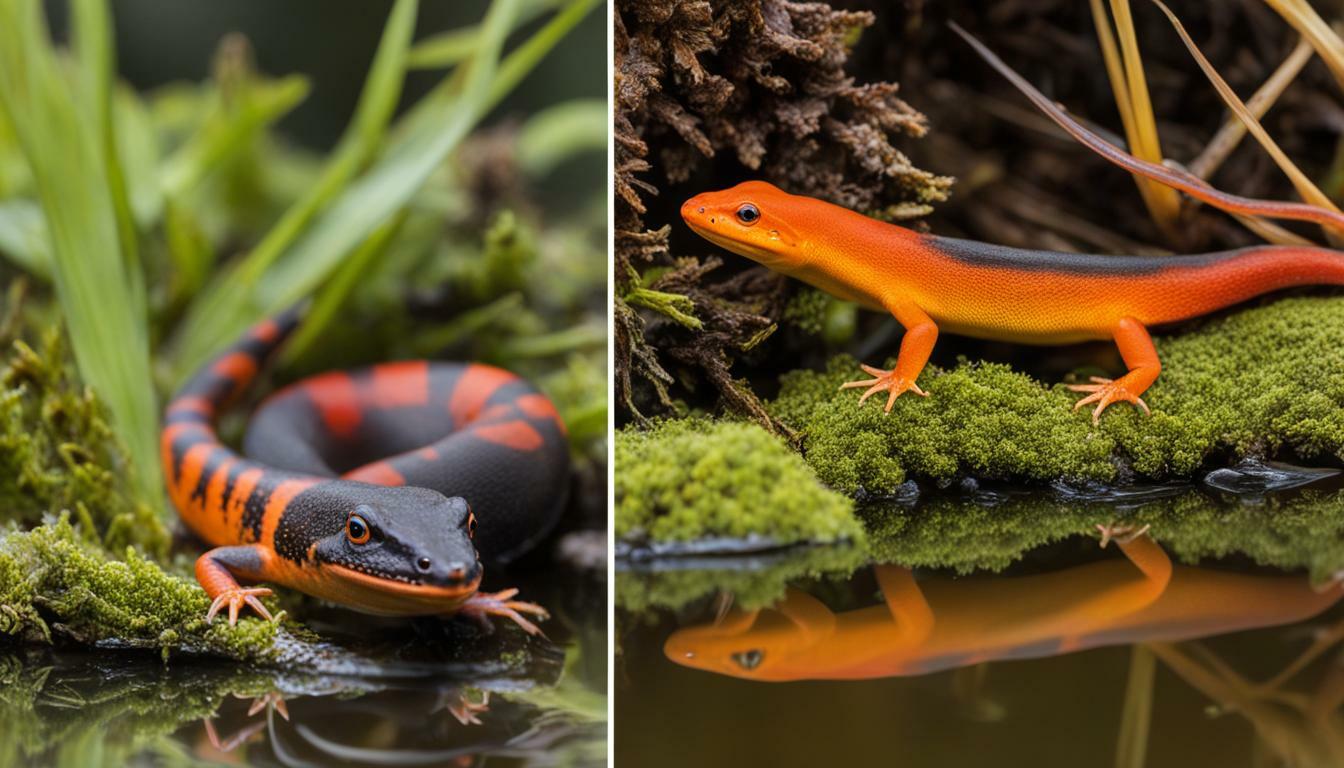California Newts and Red-Bellied Newts are two distinct species of newts found in California, but they differ in several key aspects. While they may share some similarities in appearance, there are notable differences that can help differentiate between the two.
One of the distinguishing features is the color of their eyes and eyelids. Red-bellied newts have black eyes with no yellow patches, whereas California newts have yellow patches on their eyes.
In addition to eye color, their defensive posturing also sets them apart. California newts typically do not curl their tails over their bodies, while red-bellied newts usually do.
Another way to differentiate between these newt species is by examining the underside markings and teeth pattern on the roof of their mouths. These distinct characteristics can help in identification.
It is important to note that rough-skinned newts, which belong to the Taricha species, are the most toxic. Populations of these newts in northern Oregon are more toxic than those from California and Washington. Therefore, proper handling and hand-washing precautions should be followed to avoid any problems with their toxic secretions.
Key Takeaways:
- California newts and red-bellied newts are two distinct species of newts found in California.
- They differ in eye color, defensive posturing, and markings on the roof of their mouths.
- Rough-skinned newts, a type of Taricha species, are the most toxic.
- Populations of newts in northern Oregon are more toxic than those from California and Washington.
- Proper handling and hand-washing are important when dealing with newts to avoid the effects of their toxic secretions.
Appearance and Eye Color
One noticeable difference between California Newts and Red-Bellied Newts lies in their appearance, including their eye coloration. Red-Bellied Newts have black eyes with no yellow patches, while California Newts have distinct yellow patches on their eyes, adding a vibrant touch to their overall appearance.
Aside from their eye color, both species of newts share similar physical characteristics. They have slender bodies, smooth skin, and are typically around 3 to 5 inches in length. Their bodies are adorned with various shades of brown and orange, providing excellent camouflage in their natural habitats.
Furthermore, California Newts and Red-Bellied Newts have small, delicate limbs with four toes on their front feet and five toes on their hind feet. This adaptation enables them to navigate through their environment with ease, whether it be on land or in the water.
Eye Color Comparison
| Newt Species | Eye Color |
|---|---|
| California Newts | Black eyes with yellow patches |
| Red-Bellied Newts | Black eyes with no yellow patches |
Overall, the eye color of these newt species not only adds to their unique aesthetic appeal but can also serve as a helpful visual clue in differentiating between California Newts and Red-Bellied Newts.
Defensive Posturing
When it comes to defensive behaviors, California Newts and Red-Bellied Newts have distinct ways of protecting themselves. California newts, for example, typically do not curl their tails over their bodies when threatened. Instead, they rely on other mechanisms to ward off potential predators. One such mechanism is their ability to excrete toxic secretions through their skin, making them unappetizing to predators.
In contrast, Red-Bellied Newts have a unique defensive posture. They often curl their tails over their bodies, forming a protective barrier. This behavior not only makes them appear larger and more intimidating but also serves as a shield, making it difficult for predators to access their vulnerable body parts.
Defensive Posturing Table
| Newt Species | Defensive Posturing |
|---|---|
| California Newt | No tail curling |
| Red-Bellied Newt | Tail curling for protection |
It is important to note that these defensive behaviors are not interchangeable between the two species. California Newts rely on their toxic secretions, while Red-Bellied Newts utilize tail curling as their primary defensive mechanism. The contrasting postures highlight the adaptability and evolutionary strategies employed by these amphibians to survive in their respective habitats.
Understanding the defensive posturing of California Newts and Red-Bellied Newts is crucial for researchers, conservationists, and enthusiasts alike. By recognizing the distinct behaviors and responses of these newt species, we can better appreciate their unique adaptations and contribute to their preservation in their natural habitats.
Underside Markings and Teeth Pattern
By examining the underside markings and teeth pattern, it is possible to identify whether a newt belongs to the California or Red-Bellied species. The underside markings of California newts typically consist of bold, dark lines that form a distinct pattern. In contrast, Red-Bellied newts have more intricate and intricate patterns, with lighter markings and spots.
Additionally, the teeth pattern on the roof of the mouth can provide further clues for species identification. California newts have tooth-like ridges that are evenly spaced along the roof of their mouth, while Red-Bellied newts have a more irregular arrangement with fewer teeth.
| Newt Species | Underside Markings | Teeth Pattern |
|---|---|---|
| California Newt | Bold and distinct dark lines | Evenly spaced tooth-like ridges |
| Red-Bellied Newt | Intricate and lighter markings | Irregular arrangement with fewer teeth |
These unique characteristics in the underside markings and teeth pattern provide important markers for distinguishing between the California and Red-Bellied newt species. They can be valuable tools for researchers, conservationists, and enthusiasts interested in studying and identifying these fascinating amphibians.
Toxicity and Populations
It is important to note the varying toxicity levels and regional populations of California Newts and Red-Bellied Newts when handling these amphibians. Among the Taricha species, the rough-skinned newts are considered the most toxic. Their skin secretions contain a powerful neurotoxin called tetrodotoxin, which can be harmful or even deadly if ingested or if it comes into contact with open wounds or mucous membranes. The toxicity levels of newts can vary depending on their geographical location.
In northern Oregon, the populations of rough-skinned newts are known to be more toxic compared to those found in California and Washington. This difference in toxicity is thought to be related to the diverse range of prey items available to the newts in each region. The newts in northern Oregon primarily feed on highly toxic prey, such as rough-skinned salamanders, which allows them to accumulate higher levels of toxins. On the other hand, the populations of California Newts and Red-Bellied Newts in California and Washington have been observed to have lower toxicity levels.
When interacting with these fascinating creatures, it is crucial to exercise caution. If handling newts, it is recommended to wear protective gloves and avoid any direct contact with the skin or secretions. It is also important to thoroughly wash hands and any equipment used after handling newts to eliminate the risks associated with the toxins they produce. By being aware of these toxicity differences and regional variations, we can ensure the safety of both humans and newts while appreciating the unique characteristics of these amphibians.
| Species | Toxicity Level | Geographical Region |
|---|---|---|
| Rough-skinned newt | High | Northern Oregon |
| California Newt | Medium | California |
| Red-Bellied Newt | Low | California, Washington |
Habitat and Distribution
Understanding the habitat requirements and distribution of California Newts and Red-Bellied Newts provides valuable insights into their ecological roles. These amphibians have adapted to different environments within California, each with its own unique set of characteristics. California newts can be found in a variety of habitats, including woodlands, forests, and grasslands, while Red-Bellied Newts are more commonly found in coastal regions, such as marshes, ponds, and damp forests.
California newts are particularly prevalent in the northwestern part of the state, where the climate is cooler and more moist. They are known to migrate during the breeding season, often traveling long distances to reach aquatic breeding sites. In contrast, Red-Bellied Newts tend to have a more limited distribution, mainly restricted to the central and southern coastal areas of California.
Both species prefer habitats with access to freshwater, such as ponds, streams, and wetlands. These amphibians rely on the availability of water for breeding and reproduction. They lay their eggs in aquatic settings, where the larvae develop before transforming into their adult forms. It is worth noting that California newts have been found to have a higher tolerance for brackish water than Red-Bellied Newts, allowing them to inhabit a wider range of aquatic environments.
Table 1: Habitat Preferences and Distribution of California Newts and Red-Bellied Newts
| Newt Species | Habitat | Distribution |
|---|---|---|
| California Newts | Woodlands, forests, grasslands | Primarily in northwestern California |
| Red-Bellied Newts | Marshes, ponds, damp forests | Central and southern coastal areas of California |
In summary, California Newts and Red-Bellied Newts have distinct habitat preferences and distribution patterns within California. Their ability to thrive in different environments contributes to the overall biodiversity of the region. Monitoring and preserving their habitats are crucial for maintaining the ecological balance and ensuring the survival of these fascinating amphibian species.
Behavior and Reproduction
California Newts and Red-Bellied Newts exhibit distinct behavior and reproductive traits that set them apart from each other. Understanding these differences can provide valuable insights into the lives of these fascinating amphibians.
One notable difference in behavior is their preferred habitat. California Newts typically inhabit streams, ponds, and other aquatic environments, while Red-Bellied Newts can also be found in terrestrial habitats such as forests and meadows. This difference in habitat preference can influence their behavior, as California Newts are more aquatic and often spend a significant portion of their lives in the water, while Red-Bellied Newts are more adapted to both land and water.
Reproduction is another area where these two newt species differ. California Newts have a more prolonged breeding season, which usually begins in the late winter or early spring and can extend into the summer months. Red-Bellied Newts, on the other hand, have a shorter breeding season that typically occurs in the early spring. During mating, both species engage in a courtship ritual where the male displays his vibrant colors and performs a series of movements to attract a female.
| California Newts | Red-Bellied Newts |
|---|---|
| Prefer aquatic habitats | Can be found in both aquatic and terrestrial habitats |
| Breeding season usually begins in late winter or early spring | Have a shorter breeding season in early spring |
In summary, California Newts and Red-Bellied Newts exhibit distinct behavior and reproductive patterns that reflect their habitat preferences and breeding habits. By understanding these differences, we can better appreciate the unique characteristics of each species and gain a deeper insight into their fascinating lives.
Conclusion
In conclusion, California Newts and Red-Bellied Newts may share certain similarities, but their varying physical traits, defensive behaviors, and habitat preferences make them distinct species worthy of exploration and conservation efforts.
One notable difference between these two newt species is the color of their eyes and eyelids. Red-bellied newts have black eyes with no yellow patches, while California newts have yellow patches on their eyes. This distinct eye coloration can serve as a visual marker for differentiating between the two species.
Another difference lies in their defensive posturing. California newts typically do not curl their tails over their bodies, while red-bellied newts usually do. This behavior can be observed when these amphibians feel threatened and showcases their unique defensive strategies.
Furthermore, the underside markings and teeth pattern on the roof of the mouth can also help differentiate between California Newts and Red-Bellied Newts. These subtle differences in anatomy provide additional clues for identifying and studying these fascinating creatures.
It is important to note that rough-skinned newts, a type of Taricha species, are the most toxic among newts. Populations in northern Oregon are more toxic than those from California and Washington. Therefore, proper handling and handwashing should be followed when interacting with these amphibians to avoid any potential problems with their toxic secretions.
FAQ
What are the main differences between California Newts and Red-Bellied Newts?
The California Newt and Red-Bellied Newt are two species of newts found in California. While they are similar in appearance, there are several distinguishing features that set them apart.
How can you tell the difference between California Newts and Red-Bellied Newts based on their eye color?
Red-Bellied Newts have black eyes with no yellow patches, while California Newts have yellow patches on their eyes.
Do California Newts and Red-Bellied Newts differ in their defensive posturing?
Yes, California Newts typically do not curl their tails over their bodies, whereas Red-Bellied Newts usually do.
Are there any markings or patterns that can help identify California Newts and Red-Bellied Newts?
Yes, the underside markings and teeth pattern on the roof of the mouth can also assist in differentiating between the two species.
Are California Newts or Red-Bellied Newts more toxic?
The most toxic of the Taricha species are the rough-skinned newts. Their populations in northern Oregon are more toxic than those from California and Washington. Proper handling and washing of hands should be followed when handling newts to avoid any problems with their toxic secretions.
 Skip to main content
Skip to main content


